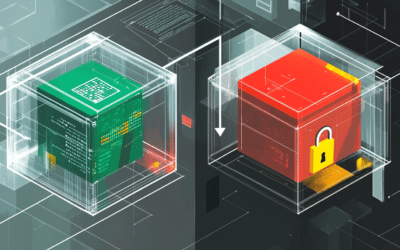
Harnessing the Synergies of DR and TEM for a Resilient and Efficient Organization
MAR, 2023
by Jane Temov.
Jane Temov is an IT Environments Evangelist at Enov8, specializing in IT and Test Environment Management, Test Data Management, Data Security, Disaster Recovery, Release Management, Service Resilience, Configuration Management, DevOps, and Infrastructure/Cloud Migration. Jane is passionate about helping organizations optimize their IT environments for maximum efficiency.
In today’s increasingly interconnected and digital world, maintaining the availability, stability, and reliability of IT systems is more important than ever. To achieve this, organizations must effectively manage and integrate two essential disciplines: Disaster Recovery (DR) and IT & Test Environment Management (TEM). While these disciplines have distinct objectives and focuses, they share many synergies that, when leveraged, can significantly enhance an organization’s IT strategy and overall resilience.
Enov8 IT & Test Environment Manager
*Innovate with Enov8
Streamlining delivery through effective transparency & control of your IT & Test Environments.
In this article, we will explore the synergies between DR and TEM, discuss best practices for integrating these disciplines, and highlight the role of Enov8, a comprehensive solution for modeling, governance, and IT orchestration, in facilitating seamless integration and collaboration between DR and TEM teams. By understanding and harnessing these synergies, your organization can optimize its processes, improve resource allocation, and ensure preparedness for both planned and unplanned events, ultimately leading to greater efficiency and resilience in an ever-changing IT landscape.
DR & TEM Synergies
Planning and Preparedness
Both DR and TEM require thorough planning and preparedness. In the context of DR, this means developing a robust plan to address potential disasters and ensure the rapid recovery of critical systems. For TEM, planning involves creating a strategy for provisioning, maintaining, and decommissioning test environments based on your organization’s needs. Integrating DR and TEM planning enables you to allocate resources more effectively, anticipate potential issues, and ensure that your environments are ready to handle unforeseen events.
Risk Assessment and Mitigation
Identifying and mitigating risks is a central aspect of both DR and TEM. In DR, risk assessment involves evaluating potential threats to your organization, such as natural disasters, cyberattacks, or equipment failures, and determining their likelihood and potential impact. In TEM, risk assessment entails identifying potential issues within test environments, such as configuration drift or resource contention, that could impact the quality and reliability of your software. By understanding the risks associated with both DR and TEM, you can develop more comprehensive strategies for preventing and addressing potential issues.
Standardization and Automation
Both DR and TEM benefit from the implementation of standardized processes and automation. In DR, this means developing repeatable operations that leverage automation to expedite recovery efforts and reduce the impact of a disaster. In TEM, standardization and automation help streamline the provisioning, configuration, and decommissioning of test environments, ensuring consistency and reducing the potential for human error. By adopting standardized processes and automation in both disciplines, you can improve the efficiency of your operations and minimize the potential for disruptions.
Continuous Improvement
DR and TEM both rely on continuous improvement to maintain their effectiveness. For DR, this means regularly testing your plan, refining it based on lessons learned, and updating it to account for changes in technology or business processes. In TEM, continuous improvement involves monitoring and optimizing test environments, addressing bottlenecks, and ensuring that environments are always meeting the needs of your organization. Integrating DR and TEM improvement efforts enables you to better identify areas for optimization and ensure that your organization remains resilient and adaptable.
Resource Optimization and Cost Reduction
Both DR and TEM have the potential to consume significant resources within your organization. By identifying the synergies between these disciplines, you can optimize resource allocation, minimize redundant efforts, and ultimately reduce costs. For instance, using a shared resource pool for both DR and test environments can help you make better use of your infrastructure and reduce the overall cost of maintaining these environments.
DR & TEM Differences
Disaster Recovery (DR) and IT & Test Environment Management (TEM) are both essential components of a robust IT strategy. However, they serve different purposes and focus on distinct aspects of IT operations. Here are the key differences between DR and TEM:
- Objective: The primary objective of DR is to ensure business continuity and rapid recovery in the event of a disaster or unplanned disruption, such as natural disasters, cyber attacks, or hardware failures. DR focuses on restoring critical systems, data, and infrastructure to minimize downtime and the impact on business operations.
On the other hand, TEM is concerned with the effective management of non-production environments used for software development, testing, and quality assurance. The primary objective of TEM is to ensure that these environments are available, stable, and configured correctly to support development and testing activities, ultimately improving the quality and reliability of software releases.
- Scope: DR encompasses the entire organization and its critical systems, data, and infrastructure. It requires a comprehensive plan that outlines the recovery objectives, backup and recovery strategies, communication plans, and roles and responsibilities of team members during a disaster.
TEM, in contrast, focuses specifically on the management of test environments, including provisioning, configuration, monitoring, and decommissioning. TEM is primarily concerned with ensuring that test environments are fit for purpose and meet the requirements of development and testing teams.
- Planning and Execution: DR planning involves creating a detailed disaster recovery plan that outlines the steps to be taken during a disaster to restore critical systems and minimize downtime. This plan must be tested regularly to ensure its effectiveness and updated as needed to accommodate changes in technology, business processes, and potential threats.
TEM planning involves determining the requirements for test environments, allocating resources, and setting up processes for environment provisioning, configuration, and decommissioning. TEM execution focuses on managing the day-to-day operations of test environments and addressing issues that may arise during development and testing activities.
- Timeframe: DR is typically a reactive process that comes into play during an unplanned event or disaster. The goal is to restore operations as quickly as possible, with minimal data loss and downtime. In this sense, DR is an emergency response that is triggered when needed.
TEM, on the other hand, is an ongoing, proactive process that supports software development and testing activities throughout the entire development lifecycle. The management of test environments is a continuous effort aimed at ensuring the optimal functioning of these environments for development and testing purposes.
Best Practices for Integrating DR & TEM
To fully capitalize on the synergies between DR and TEM, it is essential to integrate these disciplines effectively. Here are some best practices for integrating DR and TEM to optimize your organization’s IT strategy:
- Establish a Unified Governance Framework: Create a unified governance framework that clearly outlines the roles, responsibilities, and processes for both DR and TEM. This framework should provide a holistic view of your IT operations and facilitate collaboration between the teams responsible for DR and TEM, fostering a seamless integration of their efforts.
- Coordinate Planning and Documentation: Ensure that the planning and documentation for both DR and TEM are closely aligned. This includes coordinating risk assessments, resource allocations, and recovery objectives. By harmonizing your DR and TEM planning processes, you can create a more comprehensive and robust IT strategy.
- Share Knowledge and Expertise: Encourage knowledge sharing and cross-training between the DR and TEM teams. This will enable both teams to better understand each other’s goals, challenges, and processes, and facilitate collaboration when addressing common issues. Additionally, sharing expertise can lead to the identification of new opportunities for optimization and improvement across both disciplines.
- Leverage Common Tools and Technologies: Utilize common tools and technologies for managing DR and TEM processes, such as monitoring, automation, and reporting. By leveraging shared tools, you can streamline processes, improve visibility, and promote consistency across both disciplines.
- Monitor and Optimize Resource Utilization: Monitor the resource utilization of both DR and TEM to identify opportunities for optimization and cost reduction. This may include sharing resources, such as hardware, software, or cloud infrastructure, between DR and test environments to minimize redundant efforts and reduce costs.
- Regularly Review and Update Processes: Continuously review and update your DR and TEM processes to account for changes in technology, business requirements, and potential threats. Regular reviews will help ensure that your integrated DR and TEM strategy remains effective and adaptable to your organization’s evolving needs.
- Implement a Continuous Improvement Approach: Adopt a continuous improvement mindset for both DR and TEM, regularly evaluating the effectiveness of your integrated strategy and making improvements as needed. This will help ensure that your organization is always prepared for disasters while maintaining efficient test environments that support software development and testing activities.
By following these best practices for integrating DR and TEM, you can optimize your organization’s IT strategy, maximize resource utilization, and ensure that your business is well-prepared for both planned and unplanned events.
Tooling for DR & TEM
Selecting the right tools is crucial for the successful integration and execution of DR and TEM processes. Effective tooling can streamline operations, improve visibility, and enhance collaboration between teams. In this section, we’ll discuss the importance of tooling for DR and TEM, and introduce Enov8 as an overarching modeling, governance, and IT orchestration solution.
Importance of Tooling for DR and TEM:
Effective tooling can greatly impact the efficiency and effectiveness of both DR and TEM. Tools for these disciplines typically focus on:
(a) Monitoring: Tracking the performance, availability, and health of critical systems and test environments.
(b) Automation: Automating repetitive tasks, such as backup, recovery, environment provisioning, and configuration, to minimize human error and expedite processes.
(c) Reporting: Generating reports and visualizations to help stakeholders better understand the status of DR and TEM efforts, as well as inform decision-making.
Enov8
A Comprehensive Solution for DR and TEM: Enov8 is a powerful platform that serves as a comprehensive solution for both DR and TEM, offering modeling, governance, and IT orchestration capabilities. Key features of Enov8 include:
a. Modeling: Enov8 provides an intuitive interface for modeling your organization’s IT systems, including critical infrastructure, applications, and data. This enables you to better understand system relationships and dependencies, which is essential for both DR planning and effective TEM.
b. Governance: Enov8 offers robust governance capabilities, allowing you to create and enforce standardized processes for DR and TEM. This includes defining roles and responsibilities, setting up workflows, and establishing policies to ensure compliance and alignment across your organization.
c. IT Orchestration: Enov8’s IT orchestration capabilities help automate and streamline DR and TEM processes. This includes automating tasks such as backup and recovery, environment provisioning, and configuration management. By leveraging Enov8’s automation features, you can minimize the potential for human error, speed up recovery efforts, and improve the overall efficiency of your DR and TEM operations.
d. Reporting and Analytics: Enov8, a platform of insight, provides comprehensive reporting and analytics capabilities, giving you valuable insights into the performance and status of your DR and TEM efforts. This helps inform decision-making, identify potential areas for improvement, and track the effectiveness of your integrated DR and TEM strategy.
Benefits of Using Enov8 for DR and TEM
By utilizing Enov8 as an overarching solution for DR and TEM, your organization can:
a. Improve collaboration between DR and TEM teams, fostering a more seamless integration of their efforts.
b. Streamline processes and reduce redundancies through the use of a unified platform for both disciplines.
c. Enhance visibility and control over your organization’s IT systems, enabling more informed decision-making and better risk management.
d. Optimize resource utilization and reduce costs by leveraging a shared toolset for DR and TEM.
In conclusion, tooling is essential for the effective integration and management of DR and TEM processes. Enov8 serves as a comprehensive solution that offers modeling, governance, and IT orchestration capabilities, enabling your organization to optimize its IT strategy, maximize resource utilization, and ensure preparedness for both planned and unplanned events.
Conclusion
In conclusion, the synergies between Disaster Recovery (DR) and IT & Test Environment Management (TEM) play a crucial role in building a resilient and efficient organization. Recognizing and leveraging these synergies allows businesses to optimize processes, improve resource allocation, and minimize the impact of disasters on their operations. By integrating DR and TEM through effective planning, risk assessment, standardization, automation, and continuous improvement, organizations can enhance their ability to maintain reliable IT systems in the face of both planned and unplanned events.
Incorporating tools like Enov8 into your IT strategy can streamline the integration of DR and TEM, offering a comprehensive solution for modeling, governance, and IT orchestration. Enov8 not only improves collaboration between teams but also provides valuable insights and automation capabilities, enabling your organization to make informed decisions, manage risks, and ultimately thrive in a competitive landscape.
By understanding the critical relationship between DR and TEM and implementing best practices for their integration, your organization will be well-equipped to handle the challenges and complexities of today’s rapidly evolving IT environment.
Other Reading
Enov8 Blog: The History of SRE
Enov8 Blog: SRE top 10 Best Practices
Enov8 Blog: DevOps versus SRE – Friends or Foe?
Relevant Articles
RAG Status: What It Is and Using It for Project Management
Effective Leadership requires effective tooling to drive successful outcomes. One tool they can use to monitor and measure progress is RAG status. RAG stands for Red, Amber, Green, and is a simple traffic light system used to communicate the current status of a...
Enterprise Architecture Tools: 11 to Be Aware Of in 2025
Enterprise architecture (EA) is an essential discipline for organizations aiming to align their IT strategy with business goals. As companies become more complex and technology-driven, having the right set of EA tools is crucial to streamline operations, improve...
What is a Staging Server? An Essential Guide
Release issues happen. Maybe it’s a new regression you didn’t catch in QA. Sometimes it’s a failed deploy. Or, it might even be an unexpected hardware conflict. How do you catch them in advance? One popular strategy is a staging server....
What is Deployment Planning? A Detailed Guide
Deployment planning, sometimes referred to as "implementation planning," is the process of creating a plan for the successful deployment of a new software or system. It involves identifying the resources, tasks, and timeline needed to ensure that the deployment is...
The Definitive Guide to Test Data Generation
Test data generation is a critical part of the software testing lifecycle, ensuring that applications are tested against realistic scenarios before going live. If you’re not testing against production-like data, you’re arguably not truly testing your application. In...
What is a Test Data Manager? A Detailed Introduction
Testing is a critical aspect of software development, and it requires the use of appropriate test data to ensure that the software performs optimally. Test data management (TDM) is the process of creating, storing, and managing test data to ensure its...











